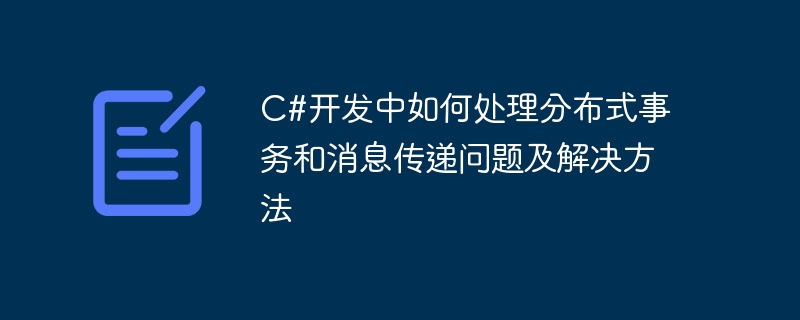

How to deal with distributed transactions and message passing problems and solutions in C# development
In distributed systems, distributed transactions and message passing are common problems. Distributed transactions refer to transactions involving multiple databases or services, while messaging refers to asynchronous communication between different components in the system. This article will introduce how to deal with these issues in C# development and provide specific code examples.
1. Distributed transaction problems and solutions
In traditional single-node transactions, the transaction processing logic is encapsulated in a database operation. However, in a distributed system, multiple databases or services are involved, which raises the issue of transaction consistency. Below are some common distributed transaction problems and corresponding solutions.
public async Task UpdateOrder(Order order)
{
using (var dbContext = new ApplicationDbContext())
{
dbContext.Orders.Attach(order);
dbContext.Entry(order).Property(p => p.Version).OriginalValue = order.Version;
dbContext.Entry(order).Property(p => p.Version).CurrentValue++;
dbContext.Entry(order).Property(p => p.Status).IsModified = true;
try
{
await dbContext.SaveChangesAsync();
}
catch (DbUpdateConcurrencyException)
{
// Handle concurrency exception
}
}
}public void PlaceOrder(Order order)
{
using (var scope = new TransactionScope())
{
// Perform database operations
var messageSession = await Endpoint.Start(new EndpointConfiguration
{
// Configuration options for NServiceBus
});
await messageSession.SendLocal(new ProcessOrderCommand
{
// Command properties
});
scope.Complete();
}
}2. Message passing problems and solutions
In distributed systems, message passing is common Decoupled and asynchronous communication methods. Different components communicate by sending messages, which can improve the flexibility and scalability of the system. Here are some common messaging problems and their corresponding solutions.
public void SendMessage(string message)
{
var factory = new ConnectionFactory
{
HostName = "localhost",
UserName = "guest",
Password = "guest"
};
using (var connection = factory.CreateConnection())
using (var channel = connection.CreateModel())
{
channel.QueueDeclare(queue: "myQueue",
durable: true,
exclusive: false,
autoDelete: false,
arguments: null);
var body = Encoding.UTF8.GetBytes(message);
var properties = channel.CreateBasicProperties();
properties.Persistent = true;
channel.BasicPublish(exchange: "",
routingKey: "myQueue",
basicProperties: properties,
body: body);
}
}public void ProcessMessage(Message message)
{
var messageId = message.Id;
using (var redis = ConnectionMultiplexer.Connect("localhost"))
{
var db = redis.GetDatabase();
if (!db.SetAdd("processedMessages", messageId))
{
// Skip processing duplicate message
return;
}
// Process the message
}
}Summary
Distributed transactions and message passing are common problems in C# development. For distributed transactions, issues such as concurrency control and exception handling need to be solved, and technologies such as optimistic concurrency control and message queues can be used. For message delivery, problems such as message loss and message duplication need to be solved, and message middleware and message deduplication mechanisms can be used. The code examples provided above can be used as a reference to help developers better handle distributed transactions and messaging issues.
The above is the detailed content of How to deal with distributed transactions and message passing issues and solutions in C# development. For more information, please follow other related articles on the PHP Chinese website!




